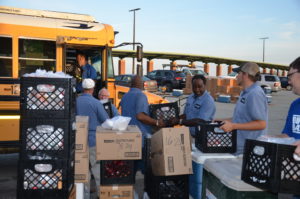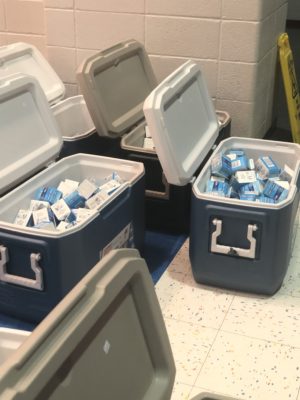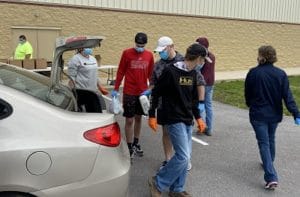With farmer’s markets brimming with vegetables and strawberries, beautiful sunny mornings and French roast coffee brewing, I could easily forget we’re still “in this” (even with a mask on!). The pandemic, the long-term lingering effects of hunger, unemployment and poverty, and the grim realities of today’s headlines can be discouraging. Wearing “rose colored” glasses may not seem appropriate, but we can’t forget there are “shining stars” among us who address the issues of food insecurity every day. Regardless of the time of the year or surrounding events, the basic needs of food, shelter and water are universal, and we need to remember they are not as attainable for some as others without a helping hand.
It Takes a Village

Burke County, GA, maintenance staff load buses for neighborhood food deliveries
Food banks, the School Nutrition Program, food distributors and the agriculture community work together through the U.S. Department of Agriculture (USDA) to provide food to families and children throughout our communities year round. During this pandemic, the importance of our essential workers along the food value chain — from meat processing plants and strawberry fields to grocery stores — has been highlighted. But, let’s not forget about the school nutrition personnel who have kept meals rolling (literally) out the doors of school cafeterias, and food bank workers who have filled boxes of food for drive-up delivery. Despite the closing of schools in March and the changes experienced with the food supply and delivery systems, these “shining stars” have continued to provide nutritious food and community support.
School Nutrition Keeps on Rolling
Since the outbreak of the pandemic, school nutrition directors from Georgia to Kentucky and beyond, have transformed their School Nutrition Programs — transitioning cafeteria serving lines into mobile food service units within days or even hours. Individual trays have moved to boxed and wrapped foods, while milk and produce are now placed in insulated coolers and transported by workers to areas of greatest need.
Donna Martin, EdS, RDN, Director of the School Nutrition Program for the Burke County, Georgia, Public Schools (and former Academy of Nutrition & Dietetic Association President), explains the transition:
“We changed operating procedures overnight and were providing meals the next morning thanks to the hard work of our staff and vendors. Our staff are essential workers as they were working 10-12 hours daily to prepare, package and distribute food for three meals daily to 5,000 children.”

Milk is ready for delivery to Burke County, GA, students
Since the schools in Burke County closed, 34 school buses, each with a three-person team, have been rolling to deliver food to students and families in need. Donna and her team created menus that utilized all the items in the school freezers as well as stocked products from vendors and distributors. Every day, children received fresh fruits, vegetables and milk along with hot and cold entrees. As a recipient of the USDA Fruit and Vegetable Grant program, the school system can provide fresh fruit daily, working with local farmers to purchase items as produce becomes available. Peaches, nectarines, blackberries, strawberries and blueberries are starting to appear on menus as fruit ripens — a “win-win” for local farmers and the children of Burke County as meal delivery continues with the Summer Food Service Program. As Donna says, “our kids are eating better than ever and the families are excited to get fresh fruit every day.”
In my own backyard, Lisa Simms, School Nutrition Director for the Daviess County, Kentucky, school system along with her managers and staff changed weekday breakfast and lunch offerings into a six-day a week meal delivery for approximately 3,000 school age children. Each family receives a combination of cold and hot entrée choices, milk and produce. As in many school districts, individual bags of food are delivered to housing units or designated sites. Lisa, working with her vendors and distributors, also was able to turn her three-month supply of commodity foods into prepared frozen entrees for distribution. Menus have continued to change to utilize products in stock as the school system has transitioned to the Summer Food Service Program, serving 2,500 meals six days per week. Along with meals, bike safety and sanitation items also are being distributed.
Even though gaps do exist, school nutrition directors throughout the country, like Donna and Lisa, have been in constant motion since March balancing children’s nutritional needs with food availability and budgets. Through collaboration with local vendors, school systems and the USDA , and the deep commitment of their staff, school nutrition programs have been able to make addressing the hunger issues of those in need a top priority.
Filling the Hunger Gap: Food and Farm Connection
Feeding America is the nation’s largest domestic hunger-relief organization with a network of 200 food banks across the country. With food insecurity rates at the highest levels ever and the potential to grow, the Feeding America network of food banks has risen to the occasion to meet the needs of 40 million people at risk of hunger.
Highlighting an example I know best, Feeding Kentucky, a state partner organization, is a system of seven food banks serving all 120 Kentucky counties in partnership with a network of over 800 local food pantries and shelters. With the current glitches in the food supply system, The Farms to Food Banks program (in place since 2011) has greatly enhanced the food supply for food-insecure residents of Kentucky and provided a pathway of support for Kentucky farmers. (Read more about the program in my April 9,2019 blog) Tamara Sandberg, Executive Director of Feeding Kentucky, says, “Our existing partnerships related to hunger relief have positioned us well” to address the current need. For example, Kentucky Farm Bureau provided a half million-dollar contribution to the Kentucky Department of Agriculture’s Hunger Initiative, from which Feeding Kentucky benefited. At present, the funds received by Feeding Kentucky have allowed them to procure 6,000 pounds of beef, 10,000 pounds of pork and 5,000 pounds of cheese from Kentucky farmers. “That is in addition to the 47,000 dozen eggs that Cal-Maine Foods donated recently thanks to the Hunger Initiative,” Tamara added. With funding from USDA and the Kentucky Department of Agriculture, cold storage capacity has been increased among the food bank network so more fresh agricultural products can be accepted. Programs like the new USDA Food Box or similar state-driven initiatives are contributing to meet food insecurity issues across the country.
Silver Linings

Burke County, GA, students with their delivered food packages
Adversity brings “silver linings” if we look for them. We may find that current policies or programs could be better. For example, there was mutual agreement among all the women interviewed that permanent enactment of some of the pandemic-related waivers could be beneficial long term. One current waiver allows for off-site consumption of meals and serving models like grab-n-go, curbside pick-up, mobile/bus routes and home delivery. Permanently removing the requirement for children to consume a meal served through the Summer Food Service Program onsite in the presence of a supervisor could guarantee increased access to meals, especially in rural areas where safe routes to access meal sites are limited. And when it comes to government support, Tamara stressed the importance of boosting the maximum Supplemental Nutrition Assistance Program (SNAP) benefit by 15%; increasing the minimum monthly SNAP benefit from $16 to $30; and suspending SNAP administrative rules that would terminate or weaken benefits. As she stated, ”SNAP is the first line of defense in the fight against hunger and for every one meal distributed by a Feeding America food bank, SNAP distributes nine.”
We Can Do Better
In our society, we are fortunate there are “shining stars’ who work tirelessly to provide the basic needs to all. But when it’s not our daily focus, what can we do? First, find out what type of food assistance programs are in your area. Is there an opportunity to help connect farmers, grocery stores or food distributors to the food banks, shelters or school systems? As Tamara mentioned, running out of food is not an immediate issue for Kentucky food banks due to the established food network, but they do face the challenge of connecting the source of food to those who need it most. Also for some, food bank usage may be a first-time experience. How do we establish a system that meets nutritional needs and preserves dignity?

No-touch food distribution at a food bank in Warren County, Kentucky
Second, consider monetary donations for food banks. Money is better than donated food during this time due to the lack of volunteers to repack donated foods. Donations to your state or the national Feeding America program, area emergency shelters and nonprofits will make a difference. Alternatively, consider “rounding up” the cost of grocery purchases as the Kroger Company is suggesting customers do through its Zero Hunger/Zero Waste Foundation’s Emergency COVID-19 Response Fund.
Resourceful, resilient, flexible and committed are all characteristics shared by those who work tirelessly in the School Nutrition Program, food banks and other food assistance programs across the country. As a society, we all need to mirror those traits and think about feeding our “neighbors” beyond our yard, farm or street. We can do better!
Resources
Feeding America
USDA National School Lunch Program
USDA Summer Food Service Program
USDA Food Box Program
USDA Fresh Fruit & Vegetable Program
USDA SNAP Program
Feeding Kentucky | Farms to Food Banks Program
Kentucky Department of Agriculture | Hunger Initiative
